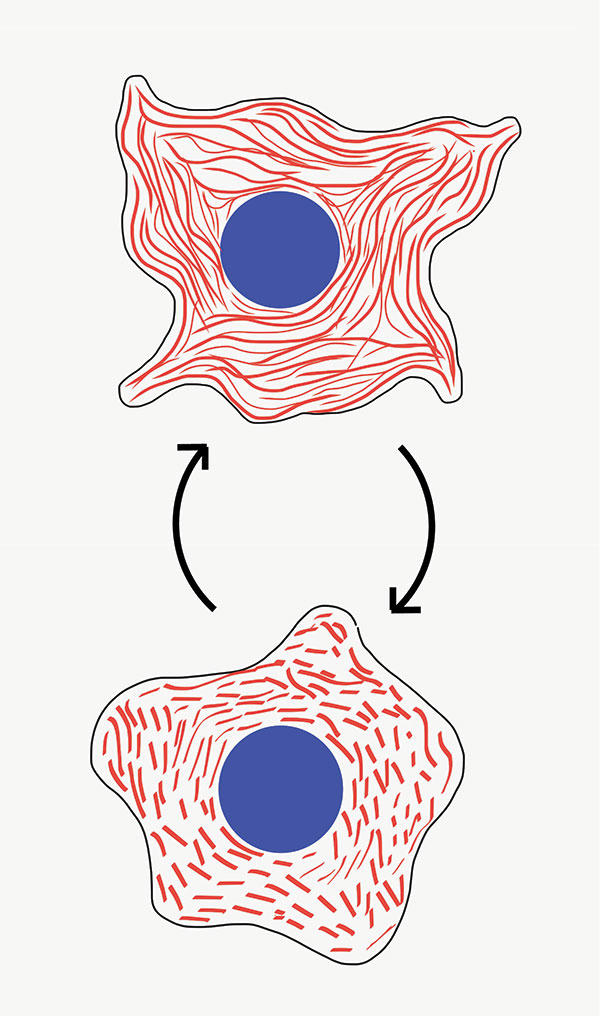The Role of Mitochondrial Dynamics in Ras-driven Cancers
, by David Kashatus
David Kashatus earned his Ph.D. with Albert Baldwin at the University of North Carolina, and did a postdoc with Christopher Counter at Duke University. He is Associate Professor at the University of Virginia School of Medicine.
The nearly universal tendency of tumor cells to exhibit increased glucose uptake and lactate secretion led to the assumption that mitochondria were not major players in the tumorigenic process. Indeed, Otto Warburg’s erroneous conclusion from his seminal work defining this metabolic shift was that “The driving force of the increase of fermentation, however, is the energy deficiency under which the cells operate after destruction of their respiration, which forces the cells to replace the irretrievably lost respiration energy in some way.” (1). As our understanding of tumor metabolism has evolved since those early days, so too has the appreciation for the multiple ways in which mitochondria participate in the multiple metabolic alterations required to support rapid proliferation. In parallel, mitochondria are no longer seen as static beans floating in the cytoplasm. We now see mitochondria as dynamic structures, changing shape and fusing and dividing and moving throughout the cell to rapidly adapt to cellular needs. It should come as no surprise, therefore, that potent oncogenes such as RAS coopt the machinery that drives mitochondrial fusion and fission. In support of this, several studies have come out in the past 5 years demonstrating how RAS, and other oncogenes such as MYC, remodel the mitochondrial network and how this shift in mitochondrial shape plays a key role in tumor growth.
Observations that mitochondrial shape is different in tumor cells started emerging around 10 years ago (2,3) and the first evidence that altering mitochondrial shape could impact tumor cell growth and survival followed shortly after (4,5). Only in the last 5 years however has solid evidence emerged that mitochondrial shape changes are direct consequences of oncogene activation. In 2015, our lab and the lab of Jerry Chipuk demonstrated that expression of oncogenic RAS and RAF lead to mitochondrial fragmentation through phosphorylation and activation of the mitochondrial fission GTPase Drp1 by Erk (6,7). In parallel, the lab of Luca Scorrano showed that Erk phosphorylates and inactivates the mitochondrial fusion GTPase Mfn1 (8). These studies demonstrated that this regulated shift towards a fragmented mitochondrial phenotype was required for cellular transformation in vitro and that its inhibition could block subcutaneous xenograft growth, suggesting that mitochondrial shape might be playing an important role in RAS- and MAPK-driven cancers in vivo. This prediction has been borne out by a number of publications in the last year demonstrating the importance of mitochondrial dynamics in KRAS-driven pancreatic cancer and revealing how this morphological shift is fundamental to Ras-driven metabolic reprogramming (9-11).
One function of mitochondrial fission is thought to be to generate smaller mitochondrial units that can more efficiently be removed through selective autophagy (mitophagy). Recent work from the Tuveson lab demonstrated that expression of oncogenic KRas leads to increased expression of the mitophagy receptor Nix (11). In a series of elegant experiments performed in tumor organoids and with a variety of mouse models, they demonstrated that increased Nix-mediated mitophagy leads to decreased mitochondrial metabolism and a shift towards glycolysis. Further, inhibition of Nix leads to decreased proliferation under glucose-limiting conditions and decreased tumor initiation in vivo. Although tumors eventually form in the absence of Nix, the upregulation of alternative mitophagy pathways in these tumors highlights how important mitophagy is in Ras-driven tumor growth. Consistent with these findings, work from our lab recently demonstrated that Drp1-dependent mitochondrial fragmentation also supports a glycolytic shift in KRas-driven pancreatic cancer cell lines and KRASG12D-expressing MEFs (9). Surprisingly, we showed that Drp1, and presumably mitochondrial fission, are required for Ras-induced Hexokinase 2 (HK2) expression and that restoration of HK2 could completely rescue the glycolytic defect observed upon Drp1 deletion. Also, as the Tuveson lab observed with Nix depletion, deletion of Drp1 led to increased survival in an autochthonous model of PDAC. However, similar to what they saw in their model, we observed that long term ablation of Drp1 eventually led to the emergence of tumor cells with restored glycolytic flux. Importantly though, these cells demonstrated decreased mitochondrial function, likely due to the loss of the turnover of damaged mitochondria. Just prior to the publication of our work, a similar study was published by the lab of Cullen Taniguchi (10). Consistent with our study, they observed that inhibition of Ras-induced mitochondrial fission led to a loss of KRas-driven transformation and pancreatic tumor growth. They also observed that the promotion of mitochondrial lengthening led to decreased mitochondrial function. Importantly, their work also demonstrated that this requirement can be exploited pharmacologically using the FDA-approved arthritis drug leflunomide, which was recently shown to be an agonist for the fusion GTPase Mfn2 and to promote mitochondrial elongation (12).
Collectively, these three studies argue that mitochondrial fission and mitophagy may be attractive targets for pancreatic cancer and other Ras-driven malignancies. Furthermore, they demonstrate how the importance of mitochondria extends beyond oxidative metabolism and how manipulation of mitochondrial structure and function can have important metabolic impacts outside of the mitochondria. It should be noted that the regulation of mitochondrial shape in cancer is not limited to Ras-driven cancers. Studies from the labs of Dario Altieri and Martin Eilers have revealed that oncogenic Myc can also regulate mitochondrial shape to promote a variety of important tumorigenic properties (13,14). Furthermore, Kris Wood and colleagues recently showed that mitochondrial dynamics are dysregulated in a variety of malignancies, leading to specific and exploitable drug sensitivities (15). Hopefully, this burst in research linking mitochondrial shape and tumor growth will spur a similar burst in the development of small molecules capable of selectively targeting the mitochondrial dynamics machinery, as this looks to be a promising new avenue in the fight against cancer.

